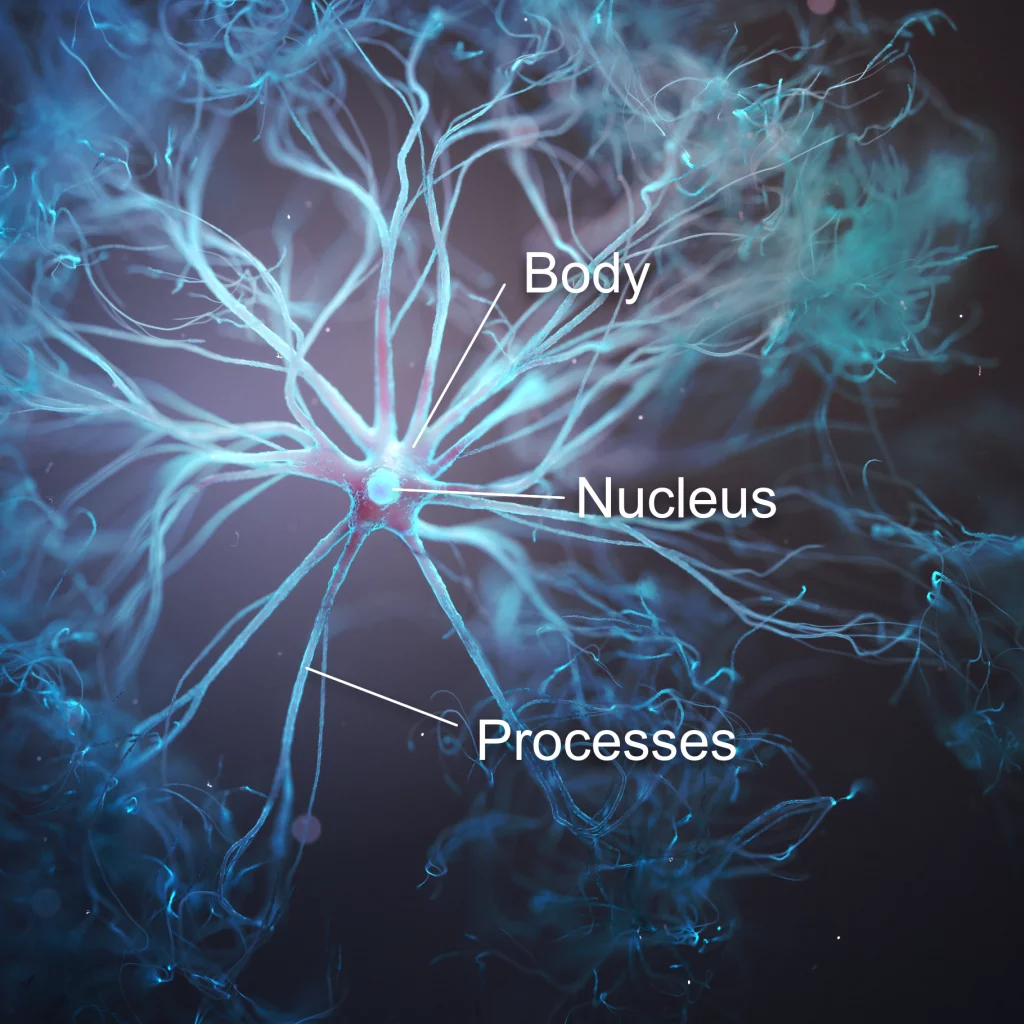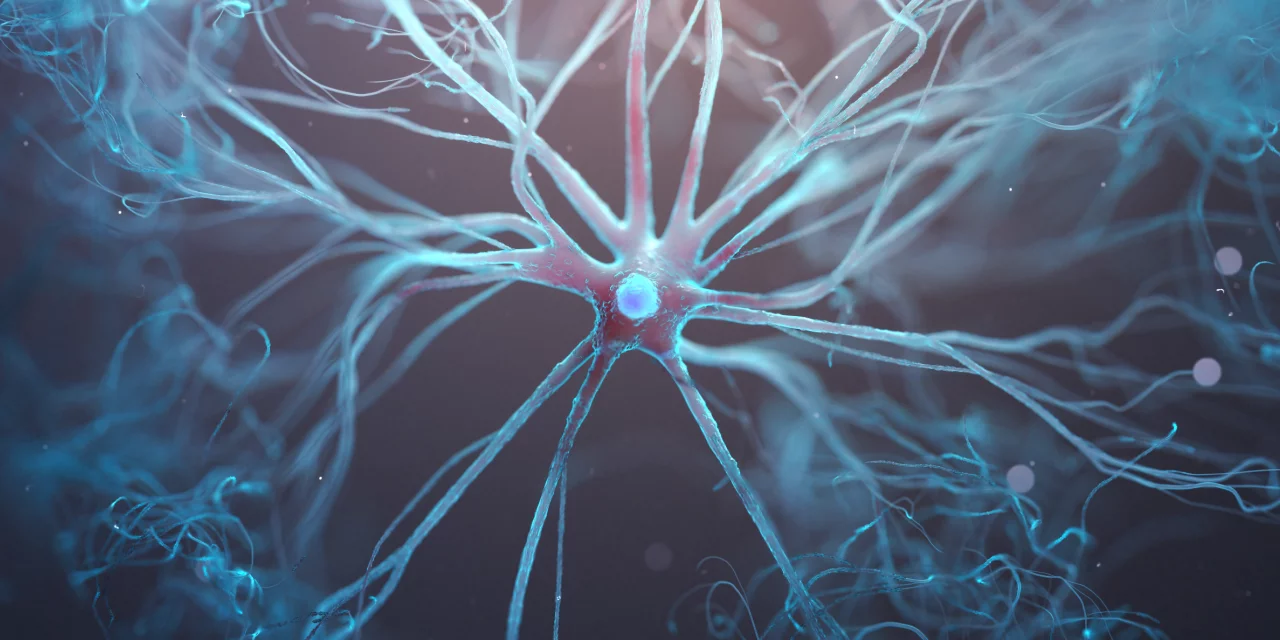
What are astrocyte cells?
Astrocytes are a type of glial cell found in the brain and spinal cord. They are the most abundant cell type in the central nervous system (CNS) and are collectively known as Astroglia.
Astrocyte cells provide structural and metabolic support to neurons.
Alternate Names
- Astroglia
- Glial cell
- Astrocytic cell
- Protoplasmic astrocyte
Anatomy and structure
What are the core elements that make up the astrocyte?
- Body
- Nucleus
- Processes
The cell body of an astrocyte is star-shaped and consists of a cell membrane, cytoplasm, and nucleus. The cell processes are long, thin extensions of the cell body that can reach out to other cells and structures.
Astrocyte Subtypes
There are two subtypes of astrocyte cells. Fibrous, which are found primarily in the white matter of the brain, and Protoplasmic which are found in the gray matter of the brain.


Function
Astrocyte cells relay signals, provide structural support and energy to neurons, and help to maintain the blood-brain barrier.
Astrocytes get the nutrients they provide to neurons from various sources, such as the circulatory system by attaching to capillaries, other cells in the brain, and the extracellular space.
Using the end of the cells processes, it attaches to basal lamina surrounding endothelial cells on nearby capillaries.
Resources
They are able to take up various substances, such as glucose, oxygen, and amino acids, and deliver them to the neurons. Astrocytes are also involved in the production of gliotransmitters, which are molecules that help to regulate synaptic transmission.
Astrocytes also help to repair damaged neurons and with neuronal plasticity, which is the ability of the brain to form new connections and reorganize itself.
Life Cycle
Birth
Astrocytes are long-lived cells that do not divide or replicate. They are formed during development from neural stem cells and remain in the CNS for the life of the organism.
Death
When astrocytes reach the end of their life they undergo apoptosis, which is a normal and controlled process know as programmed cell death. Apoptosis can also be triggered by other causes such as cellular stress.
How do astrocyte cells Relate to Health?
Astrocytes play a critical role in the functioning of the CNS and are essential for normal brain function. Dysfunction of astrocytes has been linked to a variety of neurological diseases, including, Alzheimer's disease, Parkinson's disease, and multiple sclerosis.
Related diseases
- Alzheimer's: A progressive neurological disorder characterized by memory loss, confusion, and changes in behavior.
- Parkinson's: A neurological disorder characterized by tremors, stiffness, and difficulty with movement.
- Multiple Sclerosis: An autoimmune disorder characterized by inflammation of the nerves in the brain and spinal cord.
Fun facts
- A single astrocyte cell can interact with up to 2,000,000 (2 million) neuron synapses.
- Astrocytes are the most abundant cell type in the CNS.
- Astrocytes outnumber neurons in the human brain.

Summary
Astrocytes are glial cells in the brain and spinal cord. They are the most abundant cell type in the CNS and play a critical role in the functioning of the CNS, providing structural and metabolic support to neurons. Dysfunction of astrocytes has been linked to a variety of neurological diseases, including Alzheimer's disease, Parkinson's disease, and multiple sclerosis.
Created by BookofCells.com
Published:
For any questions or comments please reach out!
Email: bookofcells@gmail.com
If you found our content interesting or useful, sharing helps us out and we really appreciate it!
For additional content and to be the first to see new cells follow us on Twitter!
Thank you for visiting BookofCells.com!
Explore more cells bellow
Sources
MacVicar, B. A., & Newman, E. A. (2015).Astrocyte Regulation of Blood Flow in the Brain. Retrieved from https://doi.org/10.1101/cshperspect.a020388 on Jan. 7, 2023. National Cancer Institute (2015).Astrocyte. Retrieved from https://www.cancer.gov/publications/dictionaries/cancer-terms/def/astrocyte on Jan. 7, 2023. Harada, K. Kamiya, T. Tsubio, T. (2015). Gliotransmitter Release from Astrocytes: Functional, Developmental, and Pathological Implications in the Brain. Retrieved from https://www.researchgate.net/ on Jan. 7, 2023. Kim, Y. Park, J. Choi, Y. (2019). The Role of Astrocytes in the Central Nervous System Focused on BK Channel and Heme Oxygenase Metabolites: A Review. Retrieved from https://www.ncbi.nlm.nih.gov/ on Jan. 8, 2023. Wikipedia (2023). Astrocyte. Retrieved from https://en.wikipedia.org/wiki/Astrocyte#:~:text=The%20proportion%20of%20astrocytes%20in,cell%20type%20in%20the%20brain. on Jan. 8, 2023. Allen, N. Eroglu, C (2017).Cell biology of astrocyte-synapse interactions. Retrieved from https://www.ncbi.nlm.nih.gov/ on Jan. 8, 2023. Giffard, R. (2005).Cell biology of astrocyte-synapse interactions. Retrieved from https://pubmed.ncbi.nlm.nih.gov/ on Jan. 15, 2023.Other Cell Interactions
Neurons
Oligodendrocytes
Microglia

Neuron Cell-Coming soon
